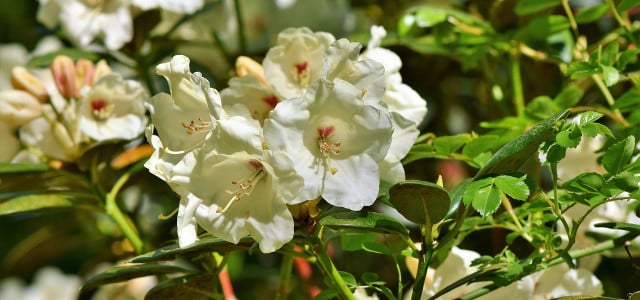
Although the rhododendron is actually very easy to care for, it is not spared from diseases. In this article you can read how to recognize and correctly combat various rhododendron diseases.
Rhododendron diseases can have very different causes. Fungi or animal pests often attack the evergreen plants. In addition, too few nutrients or an unsuitable location can cause the leaves of the rhododendron to be damaged by specific leaf diseases.
Contents
- 1 Common disease of rhododendron: chlorosis
- 2 Rhododendron diseases: Bud dieback
- 3 Detect and control rhododendron cicada
- 4 Other rhododendron diseases: Rhododendron wilt
- 5 Powdery mildew in rhododendron
- 6 Treat and prevent infestation:
- 7 Rhododendron diseases: Nitrogen deficiency
- 8 Fighting the weevil on the rhododendron
- 9 Author
Common disease of rhododendron: chlorosis
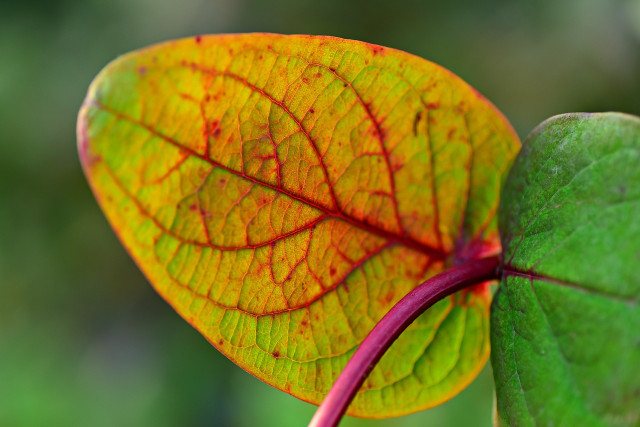
You can prevent many diseases of the rhododendron already by caring for the plant properly and placing it in a suitable location. Chlorosis, for example, is a typical leaf disease and occurs when the pH in the soil is above five: Then the rhododendron can no longer absorb nutrients such as iron or nitrogen. Dry soil in locations that are too sunny can also cause the disease.
Recognizing disease:
- The shoot tips of young rhododendron leaves turn yellow.
- Later on, the leaves take on a brown color.
- The leaf veins retain their green color and stand out clearly from the discolored leaf surface.
Treat and prevent disease:
- To prevent the disease, you should only water your rhododendron with soft rainwater.
- If your rhododendron is already diseased, you can plant it in a new location with soil that is as lime-free as possible and has a pH between 4.5 to 5. You can recognize low-lime soil, for example, by certain indicator plants or with a pH soil test.
- To prevent your rhododendron’s soil from losing moisture, you can also mulch the soil with bark humus.
Rhododendron diseases: Bud dieback
Rhododendron bud dieback is one of the diseases caused by a fungus. In this case, it is the fungus ‘Pycnostysanus azaleae’, which often occurs together with the rhododendron cicada. These insects scratch the buds of the plant and lay their eggs inside. In the process, the fungal spores attached to the insect easily reach the inside of the buds.
Detect disease:
- Over the winter, leaf buds turn brown and wither.
- The following spring, the buds of the rhododendron then no longer sprout.
- Later, the fruiting bodies of the fungus, rods about two millimeters long, grow from the buds.
Treat and prevent the disease:
- Remove all affected buds at the first sign. This will prevent the fungal spores from spreading further through the cicadas.
- Be sure to dispose of the diseased leaf buds in the household waste. Otherwise, the fungus can spread undisturbed on the compost.
- Because the rhododendron cicada is the main cause of the fungal infestation, you should combat the insect specifically. How to do this, you will learn in the next paragraph.
- Since the fungus is very stubborn, you can only fight it in the long term with a special fungicide from the garden center.
Detect and control rhododendron cicada
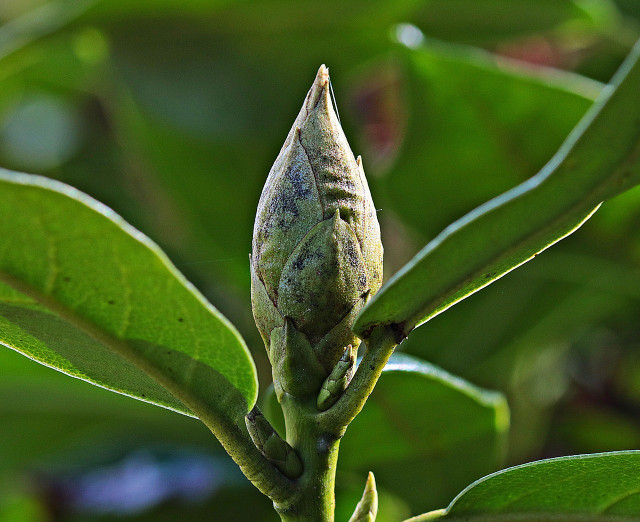
The rhododendron cicada does not actually do too much damage to your rhododendron on its own. The animals merely suck the buds and lay their eggs inside. However, by laying eggs, the cicada ensures that fungal spores enter the plant and cause the bud dieback explained above. Therefore, you should control the insect as soon as possible.
Recognize infestation:
- The brightly colored cicadas usually sit on the underside of the leaves of the rhododendron.
- The yellow-green larvae are also found on the underside of the leaves and are often mistaken for aphids.
- As a result of the fungal disease caused by the cicadas, the buds turn black and wither.
Treat infestations:
- Generously cut off the infested, black buds and dispose of them in household trash.
- To catch the adults, you can use yellow cards, for example.
- In summer, you can also catch the adults with a landing net and release them at a sufficient distance from your garden.
Other rhododendron diseases: Rhododendron wilt
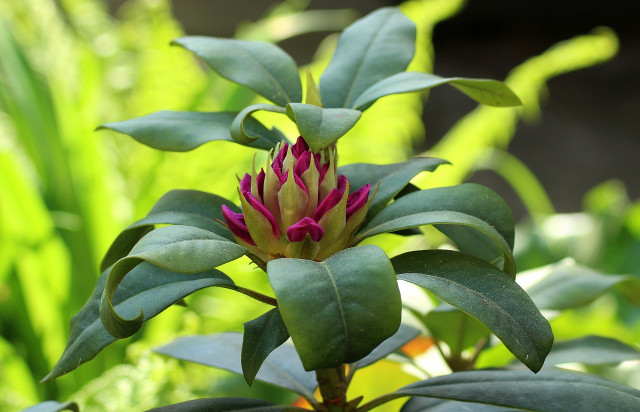
Rhododendron wilt is a fungal disease that can attack entire branches of the plant and cause it to die completely if left untreated. The fungal genus ‘Phytophthora’ can spread especially well in warm, humid climates.
Recognizing disease:
- The terminal buds of shoots, leaves and branches turn brown.
- Chocolate-colored spots appear along the midrib of rhododendron leaves.
- Leaves become dull and lackluster, take on a gray-brown color, and curl.
- Shoots and branches turn brown and begin to wilt.
Treat and prevent disease:
- As a preventative measure, protect your rhododendron from warm, humid weather and plant it in a dry, semi-sunny location. This will prevent the fungus from spreading as easily.
- As long as the root of the plant is not affected by the fungus, it is sufficient to remove the diseased parts of the plant generously. Cut the affected branches back to the healthy wood and dispose of them in the household waste.
- In the case of rhododendron wilt, you must act as quickly as possible, because depending on the type of fungus, the disease can cause the entire shrub to wither. Once the fungus has spread to the root, unfortunately, the plant can no longer be saved and must be disposed of.
Powdery mildew in rhododendron
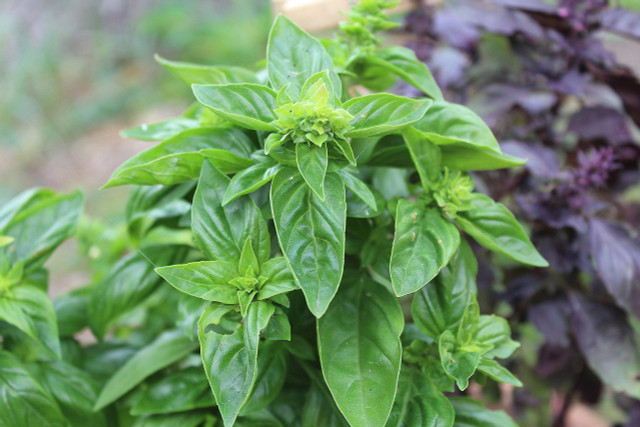
The powdery mildew is also caused by a fungus that occurs especially in rhododendron shrubs that grow too densely. Depending on the plant species, the coating on the leaves typical of the disease looks different.
Recognizing disease:
In deciduous rhododendrons, a grayish-white coating appears on the leaves.
In wintergreen rhododendrons, yellow spots cover the leaf surface.
The coating prevents the leaves from photosynthesizing and they slowly die.
Treat and prevent disease:
- To prevent powdery mildew, plant your rhododendron in a dry and, most importantly, well-ventilated spot. Also, make sure there is enough spacing between each plant.
- Plant the rhododendron near plants that are resistant to mildew, such as garlic or basil.
- Cut off infested leaves as soon as possible and dispose of them in the household trash.
- To effectively control powdery mildew, you can resort to many different home remedies, for example, milk spray cures or plant dips made from comfrey.
Rhododendron bug infestation
The rhododendron bug is one of the best-known pests of the heather plant. The bug lays its eggs in summer, primarily on the underside of leaves of purple-flowered rhododendron species.
Recognize infestation:
- Leaves are mottled light and dark.
- You will find dark spots of droppings on the underside of the leaves.
- The leaf edges bend and wither in the later stages.
Treat and prevent infestation:
To keep the rhododendron bug away, you can water your plants regularly with some nettle manure and mulch the soil.
If you notice the rhododendron bug eggs already in winter, you can simply rinse them off with warm water.
If the larvae have already hatched in the spring, you can only treat your rhododendron with an insecticide.
Rhododendron diseases: Nitrogen deficiency
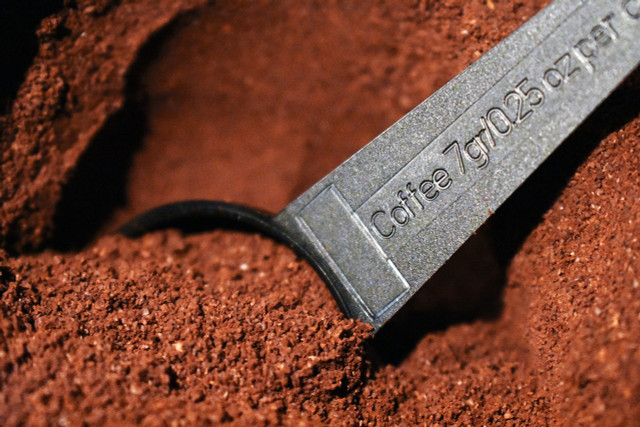
If the rhododendron can not absorb enough nitrogen through the soil, deficiency symptoms quickly appear on the plant. This is because without nitrogen, the leaf green, which is important for photosynthesis, can no longer be formed sufficiently.
Recognizing disease:
- Older leaves lighten and slowly turn yellow.
- As the disease progresses, all rhododendron leaves take on a light green to yellow color.
- Leaf veins also become lighter in color.
- If the deficiency is not controlled, the rhododendron will eventually drop the older leaves.
Treat and prevent disease:
To add more nitrogen to your rhododendron, you must first prepare the soil with nitrogenous fertilizer. It is best to use compost or coffee grounds.
Cut off already damaged leaves and shoots so that the fertilized rhododendron can sprout again.
Fighting the weevil on the rhododendron
The thick-mouthed weevil can also be very dangerous to rhododendrons. While the adults feast on the leaves, the larvae eat the roots of the plant. Because the beetle is nocturnal and its eggs are difficult to detect, it is not easy to identify this rhododendron disease early.
Recognize
- Leaf edges and leaves clearly show feeding marks and subsequently look very frayed.
- Later, the roots are also eaten.
- The rhododendron stops growing and eventually dies.
- Treatment and prevention
The best way to combat the larvae of the largemouth weevil that live in the soil is to use natural predators. Nematodes, which you can buy at garden supply stores, are especially good for this.
If the beetles sit on the leaves at night, you can simply collect them.


